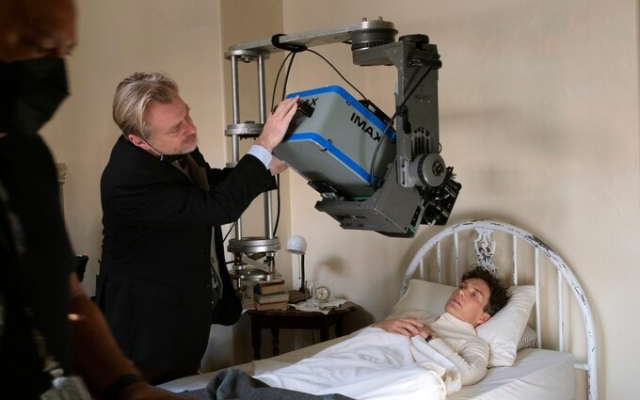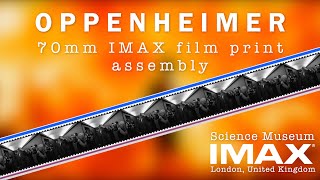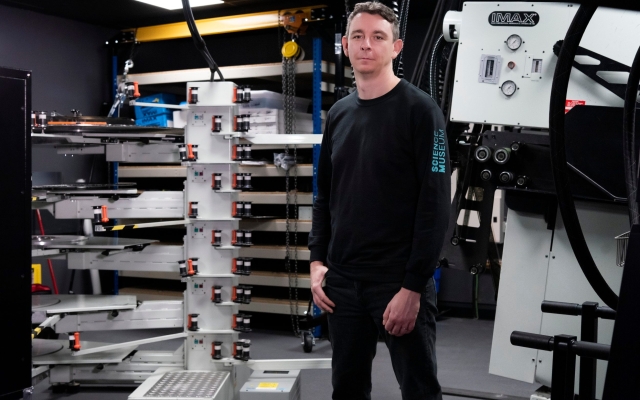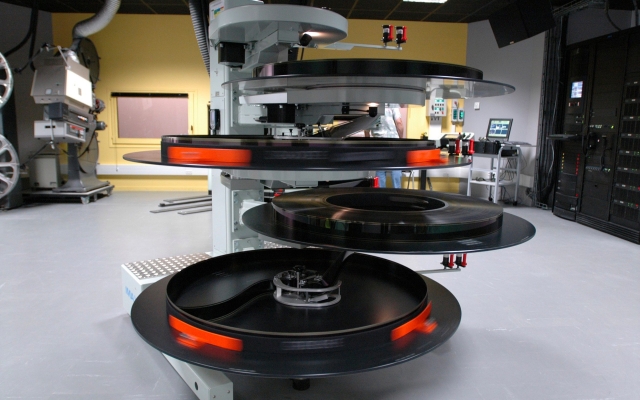 Christopher Nolan filming Oppenheimer with an Imax camera
Christopher Nolan filming Oppenheimer with an Imax camera
Matthew Raymond blows dust like his life depended on it. “Dust is the enemy,” he confirms with a smirk as he pulls his 6-foot frame out of the tangle of wires and humming equipment. And it gets everywhere.
We're in the Kensington Science Museum's Imax projection room, where Raymond leads a team of four technicians who operate and maintain the projector. Looking out the porthole, I see an auditorium where steeply inclined seats face a screen six stories high. Just behind me, the projector itself hums. It's a beast: big enough to comfortably swallow a Ford Fiesta. Surrounding him, high-tech screens and keyboards are jostled by bottles of windshield washer fluid (perfect for cleaning lenses) and rags. The room smells of warm plastic; the atmosphere of 2001 meets the underwater bridge at Das Boot. There are cables everywhere.
I'm here because the moment has arrived at the Imax cinema. Thanks to the success of Christopher Nolan's Oppenheimer, the medium is on the cultural radar in a way that hasn't been since Nolan's last film, Tenet.
However, this time the feeling is different. Tenet was released in the midst of a pandemic when the idea of going to the movies seemed odd but sitting alone with 600 strangers enjoying the maximalist pleasures of Imax. Oppenheimer capitalized on the tailwind of Barbenheimer, arguably the most successful counterprogramming in film history. However, Imax's biggest booster is the movie itself. Sure, you could watch it on your phone, but its generous visual and audio brilliance encourages you to watch it on the biggest possible screen. Nolan, after all, bothered to recreate the Trinity nuclear test. The least you can do is see what he's up to.
Either way, the gambit paid off. In its opening weekend, Oppenheimer grossed $35 million from 750 Imax screens worldwide, a record for the medium and accounting for 20 percent of its total box office. And it continues to grow, grossing $114.2 million worldwide, the most of any Nolan film and eighth of any Imax film. In Los Angeles, the demand for Imax Oppenheimer screenings has been so high that theater screenings start at 6am. At the Science Museum, Raymond and his colleagues are on duty for 18 hours, with the last one leaving at 2 am. It's a strange, dizzying moment. Has Imax — long the prerogative of crazed filmmakers — finally become mainstream?

«We're seeing a younger audience looking for the Imax experience,» Raymond explains. “You still have cinephiles in their 30s and older. But with Oppenheimer we get the next generation. They want real film projection.”
Madeleine Mallett, Program Director at BFI Imax, agrees: “The crowd that comes to Imax is diverse. This is not the kind of cinema where you just walk in and pay for tickets on the day. This is the destination, the party.»
It wasn't always like that. Imax Corporation was founded in 1967 by two Canadian engineers, Graham Ferguson and Roman Kroitor, and politician and entrepreneur Robert Kerr. Unlike conventional 35mm projectors, their invention could run film horizontally through the projector, allowing the width of the image to be made larger than the width of the film. Combined with the curved screen and reclining seats, this created the signature Imax enveloping effect — 15/70 format.
The geometry of the Imax cinema is also important. Most conventional screens provide a viewing angle of about 50 degrees; curved Imax screens that extend from wall to wall and positioned closer to the audience allow for up to 70 degrees of angle. This enhances the sense of movement and immersion — after 30 degrees the human eye relies on peripheral vision, which is particularly sensitive to movement. The larger Imax screen size means you're viewing most of the movie in your peripheral vision, so you feel cinematic movement as a physical jolt in your gut.
I just saw Oppenheimer in 70mm imax. What an amazing movie. I can't wait to see what Nolan does next. Also, it's crazy how big the screen is. Imax's first film was the 17-minute Japanese nature documentary «Tiger Child», which premiered at the 1970 EXPO in Osaka. And over the next few decades, Imax was still more of a technical marvel on display at science fairs and permanent exhibitions than a legitimate evening event. Short, widescreen, beautifully shot nature documentaries were a staple of the program.
Today, Imax is still educational in nature, feeling like the format is redolent of school trips and long, rainy summer holidays. At the BFI, for example, along with a grandiose portrait of Nolan, the inventor of the atomic bomb, you can watch Mark Brownlow's 3D nature documentary Tiny Giants, about the brave chipmunk and the Sonoran desert mouse.
However, if one director is responsible for transforming this «eat greens» image, it's Nolan. “Before him, the format was unused,” Mallett says. “And he saw his potential. He grew up watching Imax shorts, so he had a very romantic idea of what it could be. [All] filmmakers consider scale, so I'm sure it was only a matter of time before someone used it. But he did it in the most beneficial way — it serves the story, not just style over content.»
 Supercharged: Cillian Murphy in Oppenheimer. Photo: Universal Pictures
Supercharged: Cillian Murphy in Oppenheimer. Photo: Universal Pictures
Hoyt van Hoytema, who has been Nolan's cinematographer since Interstellar, suggests that Nolan saw something different in the format. “The idea that it is amenable to action is a delusion. It's a very intuitive environment — it lends itself to whatever you want to dive into. For me, it's emotion. When I first used an Imax camera, it felt like love.»
Hoytema is most proud of Oppenheimer's portrait shots, especially close-ups. “I hope they give you more than just a talking face — they let you follow the story through someone else's eyes. These shots are overcharged.»
But at the other end of the process, the projectionist's job is to separate the emotion from the moving image. In a sense, style becomes content. By his count, Raymond saw Oppenheimer over 200 times; he couldn't do his job properly if he got into history every time. Tellingly, Raymond's favorite scene with Oppenheimer is the near-static setting shots of the Los Alamos facility, the image being stretched to capture the vastness of the desert. “It gives you a sense of scale, they are miles and miles away from where the explosion is going to happen. And this is an important moment in history.”
Accordingly, Oppenheimer's film has a large scope. Together with BFI and Manchester Printworks, the Science Museum is one of only three locations in the country that can project Imax onto 70mm film, providing visual resolution of 18k, as opposed to the 4k of most digital projections. For cinephiles like Nolan, the warm shimmer of film is the fabric of cinema itself; for Raymond and his team, this is also a lot of work.
 Projection manager Matthew Raymond in the Science Museum's Imax projection room. Photo: Jenny Hills
Projection manager Matthew Raymond in the Science Museum's Imax projection room. Photo: Jenny Hills
Oppenheimer's film arrived from a Los Angeles studio in 53 individual reels, each of which had to be rewound individually before being spliced and glued together by hand, a process that took more than 18 hours. When completed, the film, resembling a monstrously large vinyl disc, was over 6 feet wide and weighed 270 kg. This is the largest Imax coil ever built. In fact, it's so big that the plate on which it spins had to be modified to accommodate its three-hour, nine-second run time. Nolan's films are getting longer — Raymond believes the director has a few more minutes of reprieve before his films no longer fit on the projector.
Raymond sits alone in his cubicle, night after night, for the duration of his work, vigilant for screen shaking or audio glitches. (Unlike digital projection, the soundtrack is separate from the film, so more visual information can be retained.) Does he ever curse Nolan for being mischievous?
He says: “It's more the fear of making a mistake, like scratching the film. All the effort spent on its creation — from the scenery, actors, capture, processing. We are the last piece of this puzzle, and if we make a mistake, all this hard work will be destroyed. I compare it to flying a Concorde. This is the best way to fly, but it can be very expensive to maintain. A single film can cost over £8,000.»
There is a tactile mastery in projection that almost seems like an extension of the creative process. Of course, Raymond is now nervous whenever he is taken to a regular movie theater. (His wife forbade him to complain about poor screenings.)
 Oppenheimer arrived in 53 separate Imax films. Photo: Science Photo Library
Oppenheimer arrived in 53 separate Imax films. Photo: Science Photo Library
And that passion seems to pervade the entire Imax projectionist community. In the wake of Oppenheimer's success, Raymond joined an international WhatsApp group to share tips, arcane knowledge, and scary stories (an unnamed projectionist once ran a video without rewinding it, projecting the movie backwards — about spoilers). Imax also has audience assistants. Raymond tells me about a group of three Irish moviegoers who fly in for every new Nolan show; they started out as students, and are now touching their 30s. Indeed, Imax's commitment to quality control is such that the corporation's CTO lists his email address at the end of each video, encouraging players to contact complaints. And he reads every one! Raymond laughs.
So far, at least in the Science Museum, there was no reason to bother him. But when I click, Raymond eventually confesses to one, disastrous screening when the screen goes black 11 minutes before the finale. Unfortunately, this happened on the evening when the Irish trio were in the hall, especially when they arrived. Try as he might, Raymond could not solve the problem. In the end they did a refund.
At the moment, few filmmakers can match Nolan's commitment to Imax. The cameras are massive, noisy and expensive; films should be conceived as Imax from the start to make the most of its unwieldy potential. “When we started, Christopher was a bit obsessed with Imax and how to make it work,” explains Hoytema. “At first, our biggest goal was to free the camera; all the reasons why people should have rejected it, we were determined to overcome [them]. Now we're like a Formula 1 pit stop team, a well-oiled car.»

Among the innovations that Hoytema and Nolan pioneered was an «airship» made of insulating material to dampen some of the camera noise as well as change the shooting process. Now Nolan insists on several rehearsal takes with the camera on, so by the time they get the shot, the actors are used to the whirring squeal of a coffee grinder next to their faces. They have learned how to reduce the weight of the camera with specially designed shoulder pads for unparalleled portability and accuracy.
And there are signs that other directors are hesitant to follow Nolan's lead. For example, Michael B. Jordan's Creed III interspersed Imax sequences in the film, the first use of the technology in a sports movie. And it just pops up in films as varied as Denzel Washington's meaty action movie, The Equalizer 3 and The Nun II, horror. Denis Villeneuve's Dune 2 is expected to take full advantage of this when it releases in November.
“It's a completely different movie-watching experience,” Mallett says. “It's amazing, exciting and inspiring. When a film is shown on such a huge screen, it reminds you of what a cinematic experience is.»
However, as Hoytema reflects, technology is only as good as the film it is used on. “I'm not a snob. We may sound smug, but if I'm on a plane and someone is watching [Oppenheimer] on their phone, I won't complain. I'm just happy that people are seeing it — we've done our best to make it special, wherever you are, and yet you're watching it.»
The Imax Science Museum is taking orders for 70- mm Oppenheimer telescope. shortened to 26 August. It's being shown at BFI Imax until September 10
Have you ever seen a movie at Imax? Share your thoughts and experiences in the comments section below.


























































Свежие комментарии